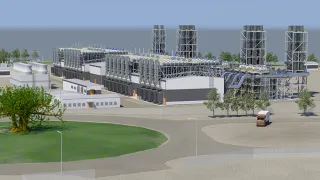Finnish technology transforms El Salvador’s energy production

According to Wärtsilä’s Director, Financial Services, Tuomas Haapakoski, the liquefied natural gas, or LNG, delivered to the power plant can replace oil-based electricity generation and reduce emissions significantly.
At the moment, El Salvador’s electricity generation capacity is approximately 1,600 megawatts and up to half of it is based on oil.
“As the use of LNG can be regulated, it is a good option for complementing solar and wind power, for instance. Only a few similar major LNG-to-power projects have been carried out in all of Latin America. There would be a need for these kinds of power plants in the Caribbean and Africa, too. These power plants are well-suited to developing countries that do not have a gas pipeline network,” says Haapakoski.
The name “LNG-to-power” refers to the combination of a power plant and a LNG terminal. The purpose of the terminal is to transfer liquefied natural gas to a power plant for electricity generation. The reason why the number of LNG-to-power plants in the world is not higher is simple: projects take years to complete and are expensive.
“These always have their own particular challenges due to the complexity of the technical infrastructure and the LNG supply chain. Therefore it is important that lenders are perseverantly involved in the project during the whole development period. Finnvera’s participation is crucial for the project’s realisation,” notes Haapakoski.
Wärtsilä has been involved in El Salvador’s investment from the outset. In six years, the company has played many roles: first, it acted as a project developer and minority shareholder, then as a contractor and a technology provider and finally it will become the operator of the power plant.
“In the future, El Salvador will be an important reference to us. As the power plant is modular and highly standardised, it is directly suitable for other LNG-to-power projects, too,” comments Haapakoski.
A considerable project in size and complexity
It has been a considerable undertaking for the project sponsors to put together the financing of this magnitude considering the size and complexity of the project.
“This is a considerable project in size and complexity. We gladly take part in a project like this, in which the multilateral providers of financing are also participating. That is an important aspect when talking about investments made in emerging economies. Finnvera’s subsidiary Finnish Export Credit Ltd finances a little less than one fourth – USD 142 million – of the project credit,” says Finnvera’s Senior Adviser Petri Vartiainen.
The multilateral providers of financing to the project are IFC, OPIC and IDB Invest of the Inter-American Development Bank.
In Finnvera’s country risk policy El Salvador is rated to category C, as are most of the Central American countries. This means that the country’s solvency is estimated to be so poor that guaranteeing long risk period credits requires specific financing structure mitigating country or counterparty risks.
"This is a considerable project in size and complexity. We gladly take part in an emerging economy power project like this, in which the multilateral providers of financing are also participating, says Finnvera's Petri Vartiainen.
"
Environmental and social impacts are assessed as part of responsible financing
The gas power plant and the LNG terminal have also kept Environmental Advisers busy. From Finnvera’s point of view, this is a Category A project, subject to the comprehensive environmental and social impact assessments related to responsible financing.
According to Finnvera’s Environmental Adviser Lauri Etelämäki, Category A usually consists of projects that are estimated to potentially be high risk investments. They are assumed to cause permanent changes in the affected area. Pulp mill and mine investments, for instance, are included in this category.
“Assessments are related to governance, employees’ rights and working conditions, emissions, land acquisition and impacts on people’s livelihood, among other things,” lists Etelämäki.
According to him, the project must meet local legal requirements and they are also compared to international standards. In practice, each assessment produces a list of things to be rectified.
“We monitor the El Salvador project throughout the loan repayment period. This has been an exceptionally multifaceted investment that requires attention to power line routing, fishermen’s livelihood, aquatic ecosystem and biodiversity, among other things” says Etelämäki.
Text: Kimmo Koivikko
Exporter: Wärtsilä Projects Oy, Finland
Guarantee Holder: KfW IPEX-Bank GmbH, Germany
Lender: Finnish Export Credit Ltd
ECA Agent: KfW IPEX-Bank GmbH, Germany
Borrower: Energia del Pacifico Ltda de C.V., El Salvador
Export transaction/Goods: EPC delivery of a 378 MWe gas-fired power facility, including 19 Wärtsilä 18V50SG Flexicycle engines
Country of export transaction: El Salvador
Guaranteed amount: USD 142 million
Repayment period: 11.5 years
Project classification: Category A
Environmental information: Basic information as well as information on environmental and social impacts were published at least 30 days before the guarantee agreement was signed. Date of publication: 25 October 2018
01_EIA T-Line Vol. I and II - Feb 2017.pdf (PDF, 74 Mb)
01_ESIA Tome I to V DEC 2016.pdf (PDF, 870 Mb)
International standards applied in benchmarking: IFC Performance Standards and relevant EHS Guidelines.
Contact point: environment(at)finnvera.fi
Information published: 22 November 2019